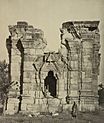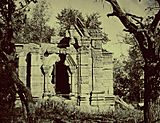Sugandha facts for kids
Quick facts for kids Sugandha |
|
|---|---|
| Sri Sugandha Deva | |

Coinage of Queen Sugandha. 'Sri Sugandha Deva' is written in Sharada script.
|
|
| Queen of Kashmir | |
| Reign | 904 – 906 |
| Predecessor | Sankata |
| Successor | Partha |
| Pretender to the throne of Kashmir | |
| Pretendence | 906 – 914 |
| Queen Regent of Kashmir | |
| Tenure | 902 – 904 |
| Monarch | Gopalavarman |
| Queen Consort of Kashmir | |
| Tenure | 883 – 902 |
| Monarch | Sankaravarman |
| Died | 914 CE Nispalaka Vihara |
| Spouse | Sankaravarman |
| Issue | Gopalavarman |
| House | Utpala dynasty |
| Father | Svamiraja |
| Religion | Hinduism |
Sugandha (lived 883 – 914 CE) was an important ruler of Kashmir in northern India during the 10th century. She was first the wife of King Sankaravarman, serving as Queen Consort from 885 CE until his death in 902 CE.
After her husband passed away, she became the Queen Regent for her young son, Gopalavarman. This meant she ruled on his behalf. In 904 CE, after her son and other possible heirs died, she was declared the Queen of Kashmir in her own right. However, she was removed from power in 906 CE by a powerful group called the Tantrins. They put a new king, Partha, on the throne.
Even after being dethroned, Sugandha still claimed to be the rightful queen. She lived in Haskapura (which is now Ushkur, Baramulla). In 914 CE, she tried to regain her throne by going to war against Partha and the Tantrins. Sadly, she was captured and later died in a Buddhist monastery.
Contents
Sugandha's Early Life and Royal Marriage
Sugandha was the daughter of Svamiraja, who was a king from a kingdom near Kashmir. She married Sankaravarman, who ruled Kashmir from 885 CE to 902 CE. During this time, Sugandha was his queen.
In 902 CE, King Sankaravarman died during a journey. Sugandha decided not to follow the tradition of Sati (where a widow would die with her husband). Instead, she chose to live and become the Queen Mother and regent for her son, Gopalavarman. This allowed her to guide the kingdom until her son was old enough to rule fully.
Sugandha was skilled at managing the kingdom's affairs. However, her treasury minister, Prabhakaradeva, gained a lot of power. He was accused of stealing from the state's money. When Gopalavarman started to investigate, the minister arranged for the young king to die mysteriously.
After Gopalavarman's death, his brother Sankata became king but also died very quickly. With no direct heirs left from Sankaravarman's family, Kashmir faced a difficult time. People started to worry about who would rule. A big public meeting was held to choose a new leader. Because Sugandha was well-liked by the people, she was chosen to become the new ruler of Kashmir.
Sugandha's Time as Queen
In 904 CE, Sugandha officially became the Queen of Kashmir. She ruled for two years, from 904 to 906 CE. She had hoped that her grandson, who was not yet born, would become the next ruler. However, this hope did not come true.
Feeling sad, Sugandha then wanted one of her relatives, Nirjitavarman, to take the throne. He was also known as "Pangu" because he was lame. But her ministers and a powerful military group called the Tantrins did not agree with her choice. They thought Nirjitavarman's lameness made him unsuitable to be king.
Because of this disagreement, the Tantrins removed Sugandha from power in 906 CE. They instead made Nirjitavarman's ten-year-old son, Partha, the new king. After being dethroned, Sugandha continued to claim she was the rightful queen. She moved to live in Haskapura, a town outside the capital.
Capture and Death of Queen Sugandha
After eight years of living in Haskapura, in 914 CE, Sugandha was convinced by her loyal bodyguards, called the Ekangas, and other supporters to fight for her throne again. A big battle took place in the areas around Srinagar in April 914 CE.
Unfortunately, Sugandha's forces were defeated, and she was captured by the Tantrins. She was put in prison and later killed in a Buddhist monastery called Nispalaka Vihara. A historian named Kalhana wrote about her fate, saying, "Strange are the ways of fate, ever falling and rising." This shows how her life had many ups and downs.
Sugandha's Lasting Impact
Some historians describe Sugandha's time as queen as a "golden age" for Kashmir. One historian, Premnath Bazaz, said that "She was loved by the people, trusted by the courtiers, and admired by the army."
Sugandha's rule is important because she was the first female ruler in Kashmir's history whose reign is clearly proven by historical records. She ruled because her people wanted her to.
During her time as queen, Sugandha built several important places. She founded the towns of Sugandhapura and Gopalapura. She also built the Vishnu temple Gopalakesava and a monastery called Gopalamatha. The Sugandesha Temple, located in Pattan, was also built by her.
Her husband, Sankaravarman, along with Sugandha, built two temples dedicated to the god Mahadeva. These were the Sankara Gauresa and Sugandhesvara temples in their new capital, Sankarapura. These two grand temples can still be seen today in modern-day Pattan.
Coins from Sugandha's reign are also very important. They show her power and even use a masculine title, Sri Sugandha Deva, for her. Many of these coins show the goddess Lakshmi sitting, and the ancient Sharda script is clearly visible on them.
Ekangas and Tantrins: Powerful Groups in Kashmir
In medieval Kashmir, during the Utpala dynasty, two powerful military groups often fought for control: the Tantrins and the Ekangas. Their rivalry often decided who would be king and who would be removed from power.
The Tantrins were a strong group of foot-soldiers. They were so powerful that they could punish or reward the rulers of the kingdom. The Ekangas were like royal bodyguards. They also had a lot of influence over the court and the state. After Sugandha was defeated in 914 CE, no ruler could fully control the Tantrins for a while.
Eventually, powerful landowners called damaras were brought in to help end this power struggle. They successfully broke the power of the Tantrins. However, this then created a new challenge for Kashmir's rulers: how to control the power of these landowners, as seen later during the rule of Queen Didda.
Timeline of Sugandha's Life




